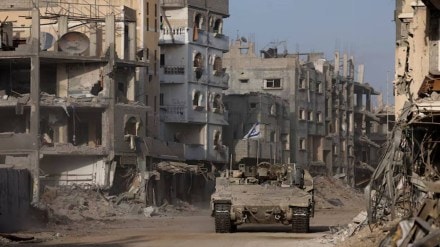The Israel-Hamas conflict, which erupted on October 7, 2023, quickly escalated into one of the most devastating and politically complex wars of recent history. What began as a surprise attack from Hamas on Israel led to extensive casualties, widespread destruction in Gaza, and a major international diplomatic effort aimed at securing a ceasefire. After 15 months of intense fighting, a landmark ceasefire agreement was reached on January 15, 2025, just days ahead of the inauguration of the US President-elect Donald Trump. Below is a detailed timeline of the key events in the conflict, highlighting its evolution and the significant moments that shaped its course.
October 2023: The War Erupts
The conflict began on October 7, 2023, when Hamas launched a coordinated attack on southern Israel. The timing of the assault, during the Jewish holiday of Rosh Hashanah, caught Israel by surprise. Over 1,200 people, including both Israeli citizens and foreign nationals, were killed in the initial attacks. More than 250 hostages were taken, including civilians, soldiers, and individuals from various countries.
In response, Israel initiated airstrikes on Gaza, targeting Hamas positions and infrastructure. October 8 saw further retaliatory strikes, while October 13 marked the beginning of mass evacuations from Gaza City, where more than one million people were urged to move south to safer areas.
While Israel continued its military response, October 21 saw the first trucks carrying humanitarian aid cross into Gaza through the Rafah border crossing from Egypt. However, access remained limited as Israel maintained a blockade to restrict weapons from entering Gaza.
November 2023: Ground Operations and Truce
By October 27, Israel launched a ground offensive in Gaza, escalating the conflict and targeting key Hamas positions. Despite these efforts, the humanitarian situation in Gaza worsened as airstrikes and ground operations caused significant civilian casualties.
On November 21, Israel and Hamas agreed to a seven-day ceasefire. This truce allowed for the exchange of hostages and prisoners: Israel released 240 Palestinian women and minors in exchange for the release of some hostages taken during the initial attack. However, by December 1, the ceasefire collapsed, and the fighting resumed with renewed intensity.
The month of December also saw tragic developments, such as the mistaken Israeli airstrike on December 15, which resulted in the deaths of three hostages. This incident sparked significant criticism within Israel regarding the conduct of the war.
2024: Escalation and International Pressure
Throughout 2024, the war continued to intensify. In January, Israel focused military efforts on southern Gaza, targeting cities like Khan Younis and Rafah. The fighting caused increasing civilian casualties, with Gaza’s already dire humanitarian situation worsening. President Joe Biden, in February 2024, publicly criticized Israel’s handling of the situation, urging the Israeli government to allow greater access for humanitarian aid into Gaza.
As the conflict dragged on, the involvement of other regional actors escalated. April 2024 saw Israeli airstrikes on Iranian military targets in Syria, which Tehran vowed to retaliate against. The cycle of escalation between Israel, Hamas, and Iran further complicated the geopolitical dynamics of the war.
By June 2024, Israel had made significant strides in dismantling Hamas infrastructure in Gaza, but heavy fighting continued. The humanitarian crisis in Gaza was exacerbated by food and water shortages, and several UN agencies reported an alarming increase in civilian casualties.
2025: Diplomatic Efforts and Ceasefire Agreement
By the start of January 2025, the conflict had raged for 15 months, with little sign of an end in sight. However, intense diplomatic efforts were underway to negotiate a ceasefire. Egypt and Qatar played central roles in facilitating talks between Israel and Hamas, while the broader international community pushed for a resolution.
On January 8, 2025, the bodies of Israeli hostages Youssef Ziyadne and his son were discovered in a Hamas tunnel in Gaza, drawing further attention to the plight of hostages still being held. US President-elect Donald Trump, set to be inaugurated on January 20, intensified pressure on both parties. Trump warned of severe consequences if hostages were not released before his swearing-in, signaling the urgency of a resolution.
The diplomatic pressure, combined with ongoing negotiations, finally led to an agreement on January 15, when Israel and Hamas reached a ceasefire. The deal included the release of the remaining hostages, along with a prisoner exchange in which Israel agreed to release several hundred Palestinian prisoners.
Looking Ahead: A Fragile Peace
The ceasefire, while a significant step forward, leaves many unresolved issues at the heart of the conflict. The humanitarian situation in Gaza remains dire, with widespread destruction of infrastructure and ongoing food and medical shortages. Moreover, the core political and territorial disputes—such as the status of Jerusalem and the future of Gaza—remain contentious and unresolved.
As the United States prepares for the inauguration of President-elect Donald Trump on January 20, the international community is watching closely. Trump’s administration has signaled that it will focus on Israeli security while navigating the broader Middle East dynamics, raising questions about the US’s role in future peace efforts. The coming months will be pivotal in determining whether the ceasefire holds and whether further steps can be taken toward a long-term resolution.
Bottomline
The Israel-Hamas war, which began in October 2023, has claimed tens of thousands of lives, caused immense suffering in Gaza, and created a complex geopolitical landscape. The ceasefire reached on January 15, 2025, after 15 months of intense conflict, marks a moment of hope, but it is fragile and uncertain. The agreement, which comes just days ahead of Donald Trump’s inauguration, is a reminder of how shifting political forces can influence the trajectory of conflicts.
Despite the ceasefire, the root causes of the conflict—long-standing political, territorial, and humanitarian issues—remain unresolved. As both Israel and Hamas assess the terms of the truce and the international community prepares for the new U.S. administration, the path to lasting peace remains unclear. The war’s legacy is likely to shape the future of the Middle East for years to come.
